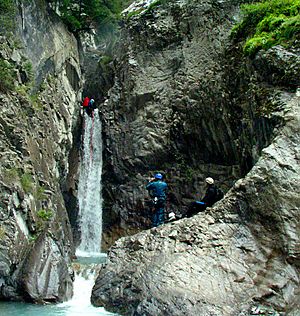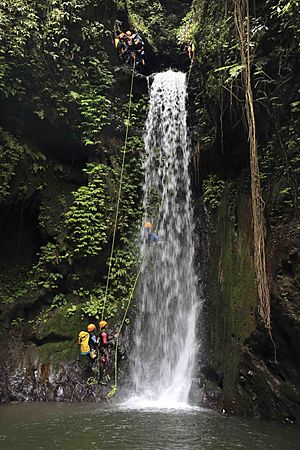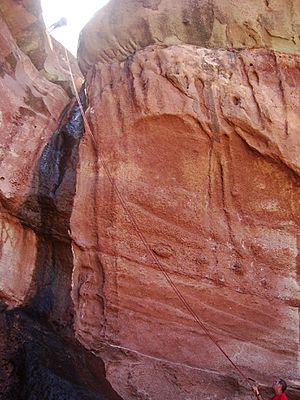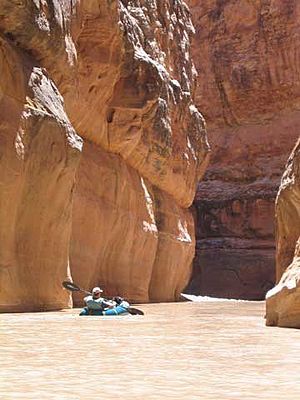Canyoning facts for kids
Canyoning is an exciting outdoor adventure where you travel through canyons. It's also called canyoneering in the United States and kloofing in South Africa. This sport combines different activities like walking, scrambling, climbing, jumping, abseiling (which is also known as rappelling), and swimming.
Sometimes, just hiking down a canyon is called canyoneering. But usually, canyoning means a more technical trip. This involves using ropes for abseiling, climbing tricky parts, making big jumps, or swimming through deep water.
Canyoning often takes place in wild, remote areas. So, knowing how to find your way and travel safely in nature is very important.
The best canyons for this sport are often carved into rock. They can have narrow passages, beautiful sculpted walls, and amazing waterfalls. Most canyons are found in limestone, sandstone, granite, or basalt rock. Canyoning trips can be easy or very challenging. The main goal is usually to have fun and enjoy the beautiful scenery. People of all ages and skill levels can enjoy canyoning around the world.
To go canyoning, you need special gear. This includes climbing equipment, strong ropes, helmets, wetsuits, and special shoes. You also need packs and rope bags. As canyoning becomes more popular, new and specialized gear is being created all the time.
Contents
Canyoning Around the World
In many parts of the world, canyoning happens in mountain canyons with flowing water. More and more countries now have companies that offer canyoning trips.
Asia
Nepal is a great place for adventure sports, including canyoning. Popular spots are Sundarijal near Kathmandu, Pokhara, and Jalabire. In Vietnam, you can try "Dalat Canyoning Challenge" in Dalat. Japan has "kyanioningu" (canyoning) and "sawanobori", which is climbing up canyons. Taiwan offers canyoning and "river tracing," which means traveling upstream.
Europe
Canyoning has become very popular in the United Kingdom. The best places for it are Wales, Scotland, Cumbria, and Yorkshire. In Welsh, canyoning is called "cerdded ceunant." It's also known as "gorge walking" or "ghyllscrambling." This means following a riverbed through a gorge, often with climbing, swimming, and abseiling.
Ticino, Switzerland, is a favorite canyoning spot. It has granite rock, clear green pools, and a nice climate. You can also find great canyoning in Slovenia, Italy, and Austria. Spain is also popular because of its warm weather and many rock formations. Portugal offers canyoning in the Azores and Madeira.
North America
In the United States, descending mountain canyons with water is often called "canyoneering." Much of this happens in the slot canyons of the Colorado Plateau. These canyons are carved into sandstone. Outside this area, you can find many canyoneering spots in the San Gabriel, Sierra Nevada, Cascade, and Rocky Mountain ranges.
Oceania
Canyoning is common in Australia. Many sandstone slot canyons in the Blue Mountains National Park are great for it. These canyons are known for needing technical abseiling at the start.
Staying Safe While Canyoning
Canyoning can be risky. Sometimes, you can't get out of a canyon from the sides. You have to finish the whole trip. Because many canyons are far away and hard to reach, getting help can take many hours or even days.
High Water and Strong Currents
Canyons with a lot of flowing water can be dangerous. They need special rope skills to travel safely. Strong currents and hidden traps in the water can pull a canyoneer under or pin them against rocks. This can lead to drowning.
Flash Floods
A big danger in many canyons is a flash flood. This happens when a lot of rain falls in the area, and the water level in the canyon rises very quickly. The rain might be far away, so canyoners might not even know it's raining. A calm or dry canyon can quickly turn into a powerful, rushing river. It's very important to check the weather forecast before you go. After a serious incident in Switzerland, authorities have set high safety standards. Companies now use a "Safety in adventures" label to show they follow strict safety rules.
Temperature Dangers

Getting too hot or too cold can also be a problem. In hot desert canyons, you can get heat exhaustion if you don't drink enough water. In any canyon with water, hypothermia (getting too cold) can be a serious danger, even in warm weather. Wetsuits and drysuits help a lot. But if you don't wear enough protection, it can be very dangerous.
Keeper Potholes
Some canyoning, especially in sandstone canyons, involves getting out of large holes called "keeper potholes." These are round pits carved by falling water. They are often too deep to stand in, and their walls are too smooth to climb out easily. Canyoneers use clever tools to escape them. These include hooks on long poles or weighted bags thrown over the edge.
Very Narrow Canyons
Some canyons are so narrow that they are smaller than a person. This makes them very difficult to pass through. Sometimes, you have to climb high up the walls, pressing against both sides to move forward. This can be tiring and means climbing without ropes for a long time. If you get stuck, rescue can be extremely hard.
The rough walls of narrow sandstone canyons can also tear clothing and gear. They can cause painful scrapes on your skin as you move through them.
Water-borne Illnesses
Being in water can expose you to illnesses like Weil's Disease or skin problems. It's best to avoid drinking the canyon water. Taking a shower right after canyoning is a good idea.
Falling Rocks
Canyons are always changing, and falling rocks are common. A moving rock caused an accident for a famous canyoneer named Aron Ralston in 2003.
Getting Lost
Many canyons are in remote areas with few paths. It can be dangerous to wander off the main route because of the tough environment.
Learning About Canyoning

As canyoning grows, more people want to learn how to do it safely. Many good organizations now offer classes. Some teach and give certifications, while others offer classes along with guided tours. These tours are popular in places like Costa Rica, Hawaii, and Utah.
Most training programs have different levels. The first levels teach basics like abseiling, using ropes, finding your way, and setting up gear. Higher levels cover more complex situations, like building anchors and how to go down different types of canyons. There are also special classes for rescue, first aid, and swift water canyons.
For people who want to become professional canyoning guides, there are several organizations worldwide. These include CIC, ICO Pro, ICA, ACA, and CGI. Many countries also have their own certification systems. In 2021, V7 Academy launched online. It offers multi-level programs, including a free course for beginners.
See also
 In Spanish: Barranquismo para niños
In Spanish: Barranquismo para niños





